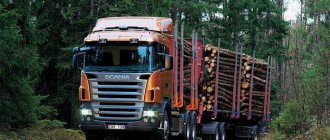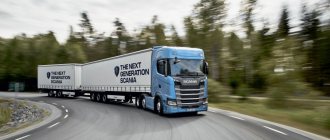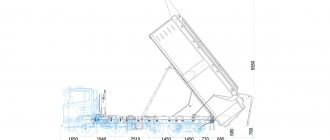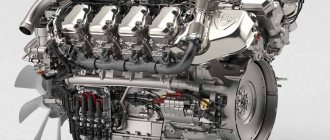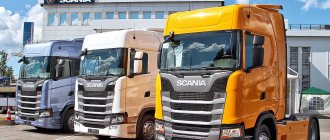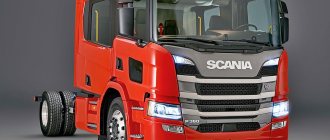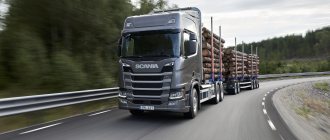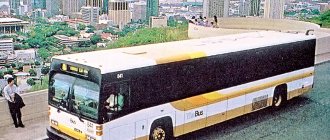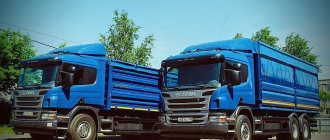This vehicle, which belongs to the class of long-haul truck tractors, rightfully occupies a leading position in the truck market. Scania R500 is designed for tough use, and is characterized by consistent reliability and high quality. Despite the fairly high cost, the car remains competitive, and its production technology is constantly being improved. The use of modern technologies and scientific developments is aimed at improving the safety of the driver, passengers and other road users, as well as reducing the operating cost of the truck.
Scania tractors cope well with heavy loads, travel long distances, and can also be used in mountain road conditions. Attractive design, power, reliability, fuel efficiency - these are just a few factors that determine the popularity of this transport among cargo carriers.
Modifications of Scania R500 tractors. Characteristics of Scania R500 LA 4×2 HNA
The R version of tractors is presented in two models. The Scania R500 LA 4×2 HNA is equipped with a 16-liter V-shaped 8-cylinder engine that complies with Euro 5 standards. Additional options include turbocharging, charge air cooler, intercooler, PDE injection system and EMS control unit. The maximum engine power is 500 hp, and the travel speed is 85 km/h.
As for the transmission, the manufacturer offers a 14-speed gearbox with two reduction gears and a Scania retarder. The clutch of this tractor is automatic, and the hypoid main gear is single-stage. The Scania R500's brakes are electronically controlled (EBS), have an anti-roll system and, depending on equipment, drum/disc brakes. The engine brake can be either automatic or manual, and parking brakes are located at the front and rear. The fuel tank is equipped with a fuel heater.
The Scania R500 chassis has a reinforced frame with a 9.5 mm side member and belongs to the H-class. The front suspension is made on parabolic springs, and the rear suspension is pneumatic. The chassis level can be adjusted quickly without using additional receivers, and it is controlled directly from the dashboard, and there is also a front axle load indicator. The chassis is equipped with a normal stiffness stabilizer located on the front axle. The maximum load on the front axle is 8.5 tons, and on the rear axle – 11.5 tons. The distance between the axles is 3.7 m.
The comfortable cabin includes two berths, equipped with a headrest and heating, a driver's seat with air suspension and a folding passenger seat. The cabin is equipped with a climate control system with air conditioning, a radio tape recorder, and a monitoring system. The power steering wheel is adjustable and has a cruise control system.
Main technical characteristics of Scania R500 CA6x4ESZ
The Scania R500 CA6x4ESZ truck tractor is equipped with a similar 8-cylinder 16-liter engine that meets Euro 4 requirements. The engine is equipped with an emission control system and a heater. In addition, the installed air intake works well even in harsh conditions. Motor power – 500 hp. The maximum speed that the car can reach is 85 km/h.
The gearbox is 12 + 2 speed, equipped with two reduction gears and two reverse gears. Drum brakes are installed on all axles of the tractor, and there is a trailer brake drive. There is a parking brake on the front and rear wheels, as well as an automatic engine brake. The front axle of the chassis has a stabilizer of normal stiffness, the maximum load on the front axle is 8.5 tons, and on the rear bogie - 30 tons. Unlike the Scania R500 LA 4×2 HNA, this tractor does not have a chassis leveling system.
The cabin has an increased level of safety and is equipped with two berths. The driver's seat belongs to the “middle” class, is located on air suspension, has heating and an adjustable shock absorber, and the passenger seat is folding.
Scania R 500 log carrier: report from the plot
Text: Maxim Sergeev Photo: Scania-Rus
Just 25-30 years ago, timber trucks worked on a short distance of 10-20 km; simply no one would go further - it was unprofitable. And today, especially in the summer, they are developing plots from which the forest has to be transported 250-300 km away. There are many explanations for this, and one of them is that logging technology has radically changed. If earlier trees were cut down, almost by hand, branches were cut off and then a skidder dragged the logs out onto the road... Now, the forest is harvested in assortments.
In the 21st century, forests are not cut down; in any case, I was not able to see a single axe, but I was able to look at modern logging complexes. Their names are snarling: harvester and forwarder. And if you translate these names into Russian, it turns out even more impressive, for example, a harvester is a “felling-delimbing-stripping machine.” The harvester cuts down the tree, frees it from bark and branches, and cuts it into logs of a certain size, 4-5-6 meters each. These are assortments. The most common dimensions are 4 m and 6 m. Modern log carriers are built for these dimensions.
The machine on which I have to work all day long is the only one in the timber industry enterprise - this is a luxurious Scania R500 with a 6X4 wheel arrangement, a V8 engine (volume 16 l), 500 hp, an OptiCruise automated transmission, inter-wheel and inter-axle locks in the rear bogie and spacious sleeping cabin. The rest drive simpler timber trucks - Scania P440, which has a 13-liter in-line six with a power of 440 hp. and a manual transmission. And the P series cabin is lower. Looking ahead, I can say that despite all the advantages of automated transmissions, local drivers still prefer mechanics; from their point of view, it is a manual transmission that allows them to fully maintain control over the car. Whether this is true or not is difficult for me to judge, but first things first.
Northern format
Currently, there are two options for logging road trains. The first is the “semi-trailer head”. The advantages of such road trains are obvious: there are much lower requirements for driver qualifications, better maneuverability and, if there is a loader on the plot and at the unloading site, higher turnover.
I got the second option: a vehicle with a body for a 6-meter log, a timber superstructure installed by the domestic company V-Kran, and components (shield and aluminum bunks) from the Finnish company Alucar, and a Pulfinger manipulator with a boom reach of 10 m. Plus, a four-axle trailer dissolution, with double tires, ABS and a bunch of electronics. By the way, the wheels on the trailer have a landing diameter of 18 inches.
When folded, the trailer fits two packages of 4-meter logs, and when unfolded, two packages of 6 m each. But in the maximally extended state, no one is working now, the overall length goes far beyond the maximum allowed in our country - 20 m - this is for a “Scandinavian hitch” - 25 .25m (maximum permitted length of a road train in Sweden, Norway and Finland). And in our conditions we have to load two 4 m packages. The weight of the vehicle is 14 tons, the weight of the trailer is 8 tons. Total: 22 tons, and we haven’t even started moving yet.
The advantages of such a timber truck are also obvious - greater autonomy, we load and unload ourselves. But operating costs are higher; you also have to carry a manipulator with you, which also weighs a lot. And very high requirements for driver qualifications. He not only needs to drive the car, but also load/unload it. And this is a masterly operation that requires not just training, but also constant experience. Here, experience decides everything - the more experience and skill, the faster the road train will be loaded, and the higher the transport turnover. It is clear that I do not have such qualifications; strictly speaking, this is my first time driving a timber truck with a manipulator. Therefore, a driver who constantly works on this Scania log carrier is traveling with me as an instructor and operator.
Foggy morning, gray morning...
In the morning, looking out the window, I thought there was fog outside... But it’s not fog, your division, it’s a small snowstorm. Nothing from the word “at all” is visible... In mid-December in the Russian north the days are short, and that’s good! Most drivers, including me, prefer to drive on winter roads at dusk or at night: headlights highlight the terrain, and you see bumps and potholes. And during the day, if there is no sun and snow is falling like this, there is a gray haze behind the windshield and one can only guess what will happen to the car in the next moment.
I got the average distance, from the transshipment base in the village of Babaevo, Vologda region, to the loading point in the forest - only 104 km. Of this, about 70 km are asphalt. And this asphalt is conditional, the road is of course cleaned with bulldozers, but not sprinkled with anything, so you have to drive on compacted snow and the asphalt part of the road differs from the primer only in that it is a little smoother.
Two hours to the plot, an hour to load, two hours back and half an hour to unload... In total, even with maximum intensity and the absence of force majeure, a day there is a maximum of two flights or 400 km on compacted snow through a blizzard...
The natural question is, how much do guys earn in such situations? (Everyone loves to count money in other people's pockets). We asked - we answer, the average salary is 60-80 thousand rubles. More in winter, less in summer. Why? Yes, simply because in the summer the wood is used mainly for paper, the roads spread out and you have to travel far to get it. In winter, industrial wood (for construction, etc.) is significantly more expensive, and it is closer to pick it up along frozen winter roads. This is the arithmetic. By the way, if you go further north, to the Komi Republic, the earnings there are even higher, but they also work there on a rotational basis.
Well, these are all lyrics, but we have a real flight
The R series cabin is the most spacious in today's generation of Scania, the interior is familiar, there is nothing special to say about it, except that it is worth mentioning that the adjustment ranges of the steering wheel and driver's seat are among the best in the class. The fourth generation Merceds Actros have approximately the same adjustments, but the fourth Actros is still a very rare beast in our area, and I have never seen it in the guise of a timber truck. Therefore, it is very difficult to convince me that there is a car more comfortable from a driver’s point of view than Scania.
We fasten our seatbelts, set the automatic transmission to normal mode, release the handbrake and set off. The 500 horsepower V8 pulls the road train without feeling it, which, in principle, is not surprising. The peculiarities of operation on compacted snow are that you cannot use a standard retarder, so as not to “collapse the road train”, because when using a retarder, the braking force comes only to the drive wheels, and the tail lives a completely independent life, but you also have to use the standard brakes very carefully - the road , rolled by a bulldozer, uneven and in which direction the car might be pulled is impossible to predict.
We reached the plot without incident in two hours. I got out from behind the wheel, and the permanent driver of the car sat down at the manipulator levers. When the master works on the manipulator, it’s a fascinating sight, footage from the movie “Rise of the Machines”... 25-30 minutes and the machine is fully loaded, all that remains is to tighten the assortments with belts. In total, about 50 cubic meters of spruce forest fit on the car and trailer, which is about 35 tons! Plus, as we remember, the curb weight of the road train is 22 tons. Total: 57 tons... on the winter road...
In general, guys with reinforced concrete nerves work here. We put the OptiCruise gearbox into power mode, and aaaaaaaaaaaaaaaaaaaaaaaatly, playing with the gas pedal, we set off. In this mode, the box goes through gears strictly one at a time. It takes about one and a half to two minutes to reach 50 km/h. And then the taiga odyssey begins... Marine associations appear because the behavior of the car has changed dramatically, the 500-horsepower V8 confidently pulls 57 tons in the snow, but if on the way to the plot we were constantly shaken by potholes, then on the way back the car goes like a big one a motor yacht, gently rolling over large bumps, and small ones completely dissolving in the suspension.
Twilight is already beginning, which means that in the light of the headlights you can see what kind of terrain you are driving on, which is absolutely not superfluous with a full load. While we were driving 30 km to the asphalt, I was not cold at all, moreover, I don’t remember very well what was around, all my attention was focused on the steering wheel and the brake pedal, if something happened, I had to brake with a very large margin. And the entire return journey took a little less than 2.5 hours.
By the way, unloading takes a third less time than loading, but when you see it in the dark, it’s basically a mechanical ballet.
That's all, the shift is over, all that remains is to talk about fuel consumption. It is clear that I do not have the experience that local drivers have, but taking into account the work of the manipulator, the full load and the fact that I had to drive the entire return trip in the power range, the average consumption turned out to be 84 l/100 km.
The renewal of the local vehicle fleet began not so long ago, but it is proceeding at a very brisk pace; almost everywhere, domestic vehicles are being replaced by foreign cars. This is not surprising; two Scanias carry as much as three domestic trucks, require less fuel and do not break down. They also love Scania equipment for its relative simplicity of design and high line-to-line ratio. Swedish cars are one of the few that start without problems at -45°C.


